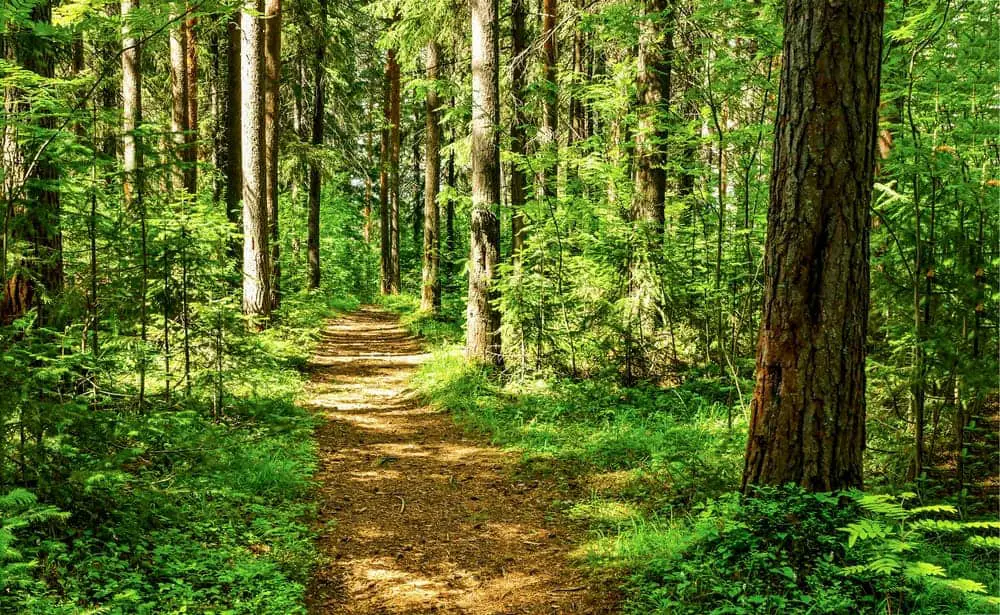
Forests are more than just magical places that provide the setting for fiction novels and spooky stories, and they cover more than a third of the earth’s surface. With more than three trillion trees making up the world’s forests, myriad living creatures call the forests home. Much more than that, though, is the fact that forests serve many vital purposes.
It’s easy to get confused by the different forest types globally, though, because they occur in so many different regions.
Forests can be broken down into tropical, temperate, and boreal types, with various sub-types according to climate, geographic location, seasonality, and leafing. Tropical forests have warm temperatures all year, while temperate forests experience four seasons with high and low temperatures. Boreal forests exist in predominantly icy regions.
Forests are defined in many different ways, and there are specific characteristics that can be used to differentiate between the types of forests. Let’s look at the broader categories that forests fall into and what sets them apart.
Table of Contents
The Forest Biome

The term ‘forest’ has been used broadly to mean an area with a large number of trees, but it’s important to remember that a forest is not just a dense area of foliage. The word ‘biome’ is more accurate to describe forests because this takes into account that a forest is a naturally occurring community of fauna and flora – a functioning system of interconnected plants and animals that rely on each other for survival.
Characteristics For Classification
While there are many colloquial terms for forests, there are ways to differentiate between forest types by looking at their geographic location, climate, and what foliage grows there. As we will see, these factors all interlink. Here is a deeper explanation of how these factors influence the type of forest:
Location, location, location!
We define forests by where they are located geographically – Northern versus Southern, as an easy example. The region where a forest is located has an impact on other characteristics, such as climate. Forests around certain areas tend to have more or less rain, higher or lower temperatures, or less sunlight.
Think about the rainforest in comparison to desert forests – everything is different, from the type of plants that grow there to the kinds of animals that live there.
Climate
Climate refers to the general weather conditions in a specific region over a long period of time. This includes humidity, average temperatures, how much sunlight the area gets, and whether there is a lot of rain or not. Climate dramatically affects the type of plants in a forest, whether these are green all year long or whether they shed their leaves during colder months.
Some plants require more sunlight, while others manage the extended winters and snowy conditions.
Seasonality
This differentiates between deciduous and evergreen forests and refers to whether the trees in the forest lose their leaves seasonally or remain green throughout the year. Deciduous trees shed their leaves in the fall, whereas evergreen trees stay lush the entire time.
Seasonality comes about due to the climate of the region, with plants in warmer, tropical areas adapting to remain green, while deciduous types lose their leaves and lay dormant during winter months.
Leafing
As a result of the abovementioned factors, the leafing of plants differs from region to region. We can use this to describe forest types, too. Some, like pine forests, have needle-leaved trees, while others are broad-leaved.
There are also conifer forests, as we will see in our discussion to follow.
The Different Types of Forests
Now that we’ve looked at what forests are and what characteristics we use to define and name them, we can look at the various types of forests. Broadly broken down into tropical, temperate, and boreal types, there are more sub-categories underneath these forest types that we can examine too.
1. Tropical Forests
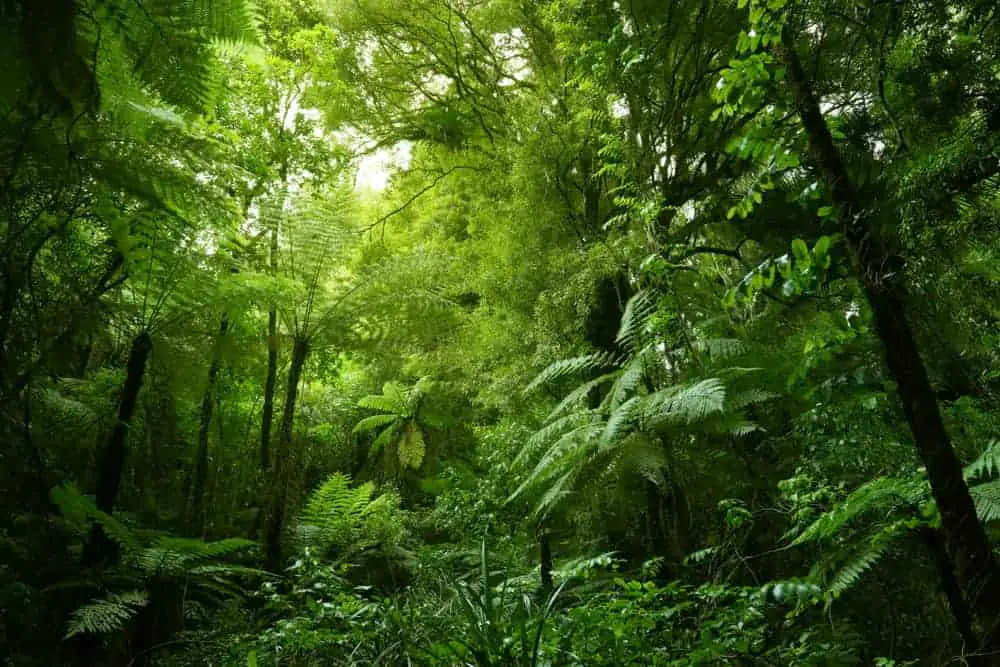
This is quite possibly the first thing that comes to mind when we hear the word forest; think humid, moist, loads of leafy-green trees, and the sound of cheerful, colorful birds in the background. This is a good description of tropical forests.
Forests like these occur naturally in areas along the equator, including Southeast Asia, sub-Saharan Africa, and Central America. The climate in regions like this is generally warm to hot, with lots of rain, ensuring a moist and humid environment. Temperatures are usually between 68 and 88˚F, and it stays typically constant with minimal fluctuations year-round.
Not all tropical forests are rainforests, however, and this category can also be broken down into the following sub-types:
Evergreen
Tropical evergreen forests are the quintessential ‘rainforests’ we see in our mind’s eye; usually, these areas receive more than 92 inches of rainfall every year. They occupy around seven percent of the earth’s surface, but – importantly – they are home to more than half of the planet’s plants and animals.
The evergreen tropical forest is usually so dense that sunlight often doesn’t reach the ground through the thick canopies. Examples of tropical evergreen forests are found in the Amazon, Malaysia, Scandinavia, and Indonesia.
Animals that call tropical evergreen forests home include gibbons, rhinos, tigers, orangutans, and pit vipers. Parrots, toucans, and a variety of raptors such as eagles, hawks, and vultures also call these forests home.
Seasonal
Seasonal tropical forests are also known as semi-evergreen, mixed, or monsoon forests, as not all of the tree species found here remain evergreen throughout the year. The climate in these regions is controlled by the Intertropical Convergence Zone, which is located near the equator. It results from the merging of the trade winds from the Northern and Southern hemispheres.
Seasonal tropical mixed forests are distinctive and have been called “jungles” colloquially. The Korup National Park in Cameroon, the national parks of Costa Rica, and the Queensland Forest reserves are all examples of this type of forest.
In this habitat, you may find gorillas, jaguars, capybaras, and the poison dart frog, to name just a few. Birdwatchers will find orioles, parrots, hornbills, and starlings among the bird species in such forests.
Dry
This seems like an oxymoron, considering tropical forests should be wet and humid, but dry tropical forests do exist and are characterized by long dry seasons that may last a couple of months at a time. During these dry times, the deciduous trees that dominate these forests lose their leaves, allowing sunlight through to the ground.
The result of this is thick underbrush and a large variety of wildlife that have learned to adapt to the tricky climate. This includes raccoons, badgers, bobcats, shrews, deer, and even kangaroo.
You’ll see forests like this in Southern Mexico, Central India, Madagascar, and the Caribbean.
Montane
While still having most of the characteristics of a traditional rainforest, Montane forests grow on mountains and above altitudes of 3,300 feet. Those that occur above 6,600 feet in elevation have the magical-sounding name “cloud forest” as they receive most of their moisture from mist or fog that is expected so high up.
Because of the altitude and moisture that passes up from the humid lowlands below, Montane forests aren’t as warm as classic rainforests. You’ll find these in the South American Andean region, Peru, Colombia, and Venezuela, as well as in Ethiopia, Uganda, and Kenya, to name just a few.
Snow leopards, spotted deer, jackrabbits, yak, and red pandas are some of the incredible animals that call montane forests home. The Andean Condor is possibly the most well-known bird residing in such regions, too, known for its sheer size and wingspan.
Tropical and Subtropical Coniferous
As the name implies, these forests are mainly characterized by the diverse species of conifers, or cone-bearing, trees. These have needle-like leaves, and the forests in these areas create a thick, closed canopy that blocks a lot of sunlight from reaching the ground. Shrubs like ferns are commonplace in this type of forest, as is a variety of fungi.
We can find coniferous forests in the Philippines, Cuba, Honduras, the Bahamas, Haiti, India, and Pakistan. Similar to other tropical forest types, coniferous forests provide a natural habitat to many birds of prey, including owls and eagles, but here you will also find black bears, grizzly bears, and wolverines.
Subtropical
Subtropical rainforests share most of the characteristics defining tropical forests but have dense vegetation on the ground level, making it a little challenging to walk through. The significant difference here is that subtropical forests have cooler winter months than tropical rainforests, although both enjoy warm and balmy summer months.
If you travel to Mexico, Southeast Asia, and India, you can find subtropical rainforests, as well as in the Southern United States. The state of Florida is an excellent example.
2. Temperate Forests
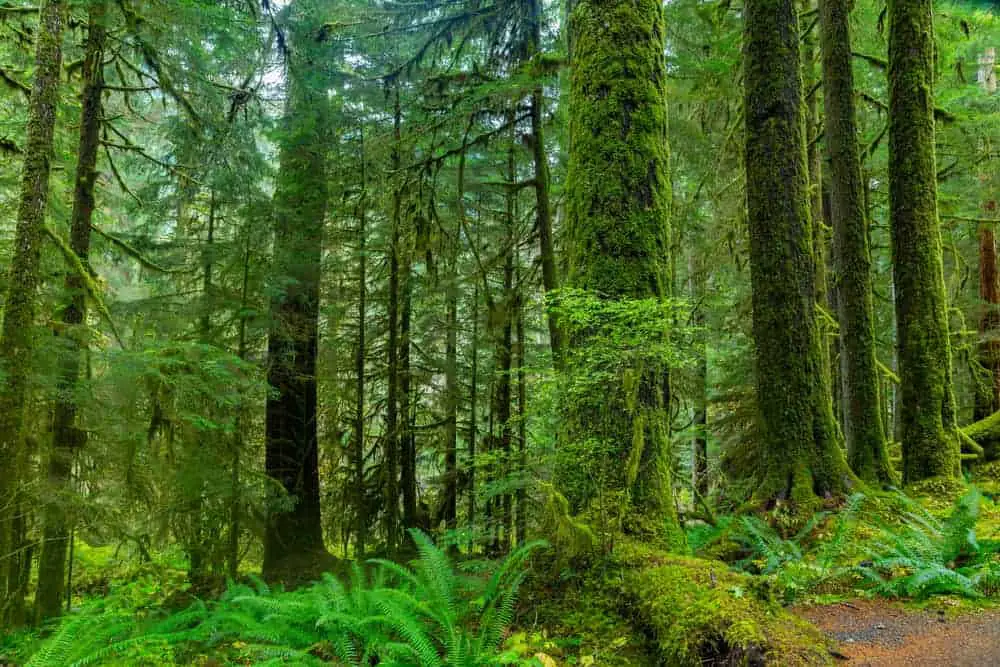
With a far broader range in average temperatures throughout the year, temperate forests are exposed to four very distinct seasons with varying precipitation elements. Temperatures vary between -22˚ and 86˚F, with typically hot summers and cold winters, and the result is trees with broad, thin leaves.
This is the second-largest forest biome and is generally found between tropical and boreal regions. There are two types of forests like this:
Deciduous
Deciduous temperate forests occur between polar regions and tropical areas and are thus exposed to both scorching and freezing air throughout the year. As the name suggests, the deciduous trees here have leaves that change color and shed in preparation for winter, where they go into a period of dormancy until spring. They flower and grow when it gets warmer.
You can find temperate deciduous forests in the Eastern United States, China, Japan, Canada, and Europe.
Animals that are common in deciduous forests include deer, opossums, porcupines, and red foxes. Salamanders, turtles, and a large variety of spiders can be found here, too. Some of the birds common to these regions migrate when it becomes cold in the winter months.
Coniferous
Conifers are needle-leaved trees that produce cones, and they are evergreen; temperate coniferous forests include pine, cedar, fir, and redwood forests.
There are many regions where you can find temperate coniferous forests, including the United Kingdom, Russia, Iran, Mongolia, Norway, Nepal, and India. North American areas known for their coniferous forests include large portions of Canada and the Central and Southern Cascades, the Colorado Rockies, and the Sierra Nevada forests in the USA.
Animals in coniferous forests have adapted to the environment. Some worth mentioning include the specialized crossbill; this bird’s upper and lower beak overlaps to pry open the cones that grow on conifers in these forests.
3. Boreal Forests
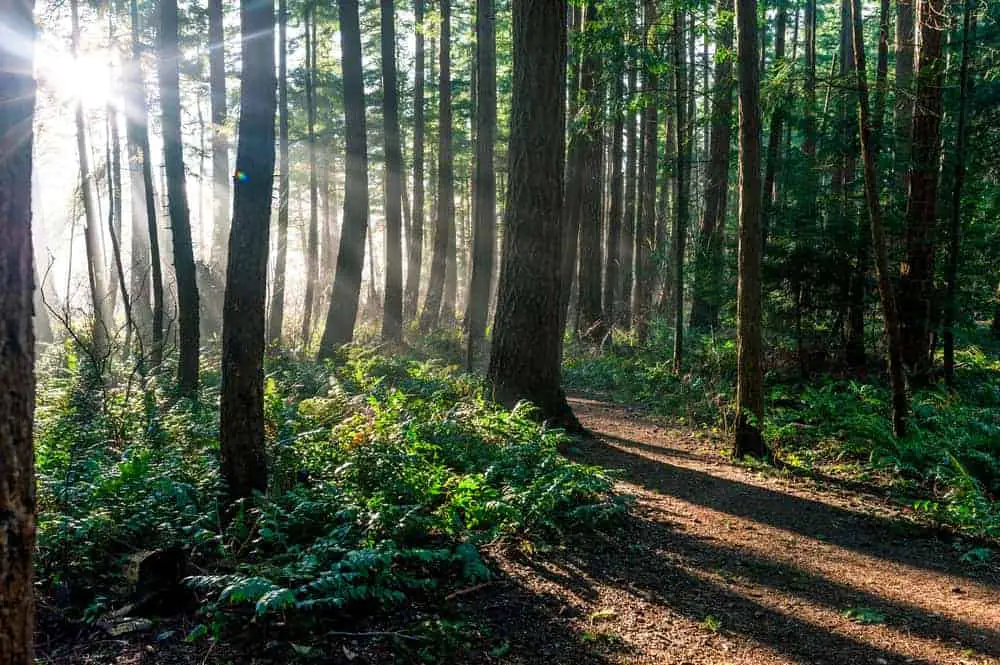
Also known as taiga or snow forests, boreal forests are unique in that the typical temperatures in boreal forests are below freezing. Boreal forests cover 11.5% of the earth, which makes it the largest biome on land.
In North America, for example, boreal forests cover much of inland Canada, Alaska, and part of the northern United States. The same is true for Sweden, Finland, Russia, Norway, and even some of the Scottish Highlands. There are some commonalities to boreal forests:
Climate
The average temperature in boreal forests ranges from 23 to 41˚F, with extreme winter temperatures dropping as low as -4˚F in some places. The lowest reliably recorded temperatures for the Northern Hemisphere were taken in the boreal forests of Russia.
A dominant feature of boreal forests is long, cold winters. Summers tend to last only one to four months, while winter can last as long as seven.
Precipitation
Less than 30 inches of precipitation is expected in these regions, and this doesn’t come only in the form of rain. Snow, fog, and mist are typical, with snow staying on the ground for almost two-thirds of the year in many areas.
Growing Season
Because of the extreme cold and precipitation, plants in boreal forests have adapted to have a longer growing season than what is outlined by the summer months. This makes sense, considering that the sun in these regions often doesn’t rise far above the horizon, meaning there is far less solar energy for the plants.
Flora
There are a few loosely defined sub-types of flora typical to taiga or boreal forests:
- Closed canopy forests: Mossy ground covering and closely packed trees are common.
- Lichen woodland/sparse taiga: Lichen covers the ground, with much less dense tree cover. Sometimes the trees are stunted in growth due to the extreme temperatures.
- High/northern, middle, and southern boreal forests: In Canada, Scandinavia, and Finland, these subzones are used to distinguish the various regions.
Fauna
Such a unique environment means that unique animals call boreal forests home. These include caribou or reindeer, moose, wolves, lynx, and a variety of martens. Tigers are also found in the boreal forests of Siberia.
There are only two remaining beaver species on earth, and both call boreal forests home. Their ability to build dams and cozy shelters helps them to survive the harsh winters. Lastly, brown bears, Asiatic black bears, and North American black bears can be found in such forests on their respective continents.
4. Other Types
While these are the most widely accepted categorizations for the forest biome, mangroves are worth mentioning, too.
Mangrove

This biome is difficult to slot into one of the categories mentioned above because mangroves occur in tropical, subtropical, and temperate areas. Typically mangroves are found between latitudes 30˚N and 30˚S. The largest mangrove area is close to the equator.
Also known as a mangrove swamp or mangal, this biome flourishes in coastal brackish water. The mangrove trees themselves are salt-tolerant trees called halophytes that have adapted to live in these conditions. Not only have they adapted to tolerate saltwater immersion and the constant motion of waves, but they thrive in low-oxygen conditions necessitated by mud.
Location
Mangroves occur in estuaries and along marine shorelines in tropical and subtropical tidal areas. The top ten countries by area of mangrove coverage include:
- Indonesia
- Brazil
- Malaysia
- Papua New Guinea
- Australia
- Mexico
- Nigeria
- Myanmar
- Venezuela
- Philippines
Mangroves can be found in Africa, too, in Kenya, Tanzania, and Madagascar. The Pacific and Caribbean coasts of Honduras, Nicaragua, Belize, Cuba, the West Indies, and the Bahamas also host mangrove biomes.
Man-Made Forests
In some areas, mangrove forests have been planted to help counteract erosion from wave impact and act to slow down tidal waters. In Vietnam, Thailand, the Philippines, and India, mangroves were planted to breed certain species of fish and crustaceans for economic purposes.
Animal Life
Both alligators and crocodiles can be found in mangrove habitats and a range of water snakes, turtles, and anoles. Three species of amphibians also live in mangroves, including the giant toad, the squirrel treefrog, and the Cuban treefrog. As mangroves occur along waterways, marine mammals like bottlenose dolphins and manatees can be found there, too, where they feed on mangrove-specific fishes or aquatic plants unique to this biome.
Due to the shallow waters that expose many aquatic organisms, wading birds are common. This includes the great egret, limpkins, and spoonbills. Mammals found in regions like these include mink, river otters, skunks, marsh rabbits, deer, and raccoons. Predators include panthers such as those found in the mangroves of South Florida, USA.
Bringing It All Together
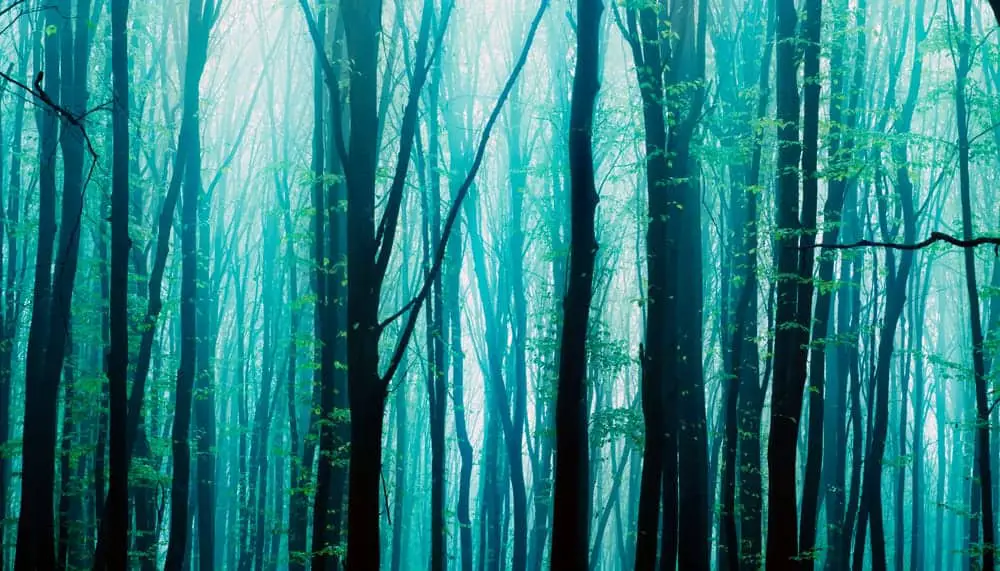
Covering an enormous portion of the earth’s surface, forests are home to millions of species – not just birds, animals, and insects, but trees and plant life that are vital to purifying the air we breathe. As we’ve learned, forests also help prevent erosion and create a home for many species of fish and animals which communities rely on for food and commerce.
One of the often-overlooked benefits of forest biomes is the cooling effect they have on the earth. As carbon dioxide is responsible for global warming, the plant life in forests actively reduces the impact of global warming by consuming carbon dioxide and releasing oxygen instead.
The fact that forests across the globe have adapted to suit the various climate changes is another miraculous aspect of these biomes. From hardy, resilient trees that can resist sub-zero temperatures and minimal sunlight to foliage that thrives in brackish water with muddied roots, forests epitomize the earth’s brilliant adaptation to survival. That being said, threats to forests and all that they are home to are increasing daily.
Threats
Ecosystems like forests do have naturally occurring threats which include fires, insect pests, adverse weather, and the like, but by far the most threatening issues come from humanity.
- Climate Change: The biggest threat is the increase in harmful emissions globally that are causing global warming. The changing climate means changes in average temperatures, precipitation, and growing seasons, affecting the species that are specifically adapted to thrive in that region.
- Deforestation: The ongoing removal or conversion of forest areas for commercial use is a considerable concern. Forests are being cut down to make space for farms, houses, and commercial zones or to use trees and other natural products. The loss of large portions of our forests means a substantial decrease in oxygen-producing plants, aggravating global warming as less carbon dioxide emissions are neutralized. Not to even mention the terrible toll this has on the eradication of natural habitat for millions of species of animals, insects, and birds.
Conclusion
The importance of forests cannot be understated. From providing fresh oxygen to breathe to preventing erosion from the elements and reducing harmful emissions that contribute to global warming, we need to protect these unique biomes.
The various types of forests are linked to their geographic locations and the climate systems that occur in each region. These can be Tropical forests, which are warm, humid, and lush, or harsh, icy, and lacking in sunlight, as we see in Boreal forests. Temperate forests straddle the line, experiencing the best of both worlds through hot and cold seasons.
References:
Way2info: 14 Different Types of Forests with Their Names and Pictures
National Geographic: Forest Biome
ZME Science: The different types of forests: everything you need to know
World Wildlife Fund: Tropical and subtropical dry broadleaf forests
Mongabay: TYPES OF RAINFORESTS
HiSoUR: SUBTROPICAL RAINFORESTS TOURISM
Biology Dictionary: Temperate Deciduous Forest
Forestry Focus: Climate Change
